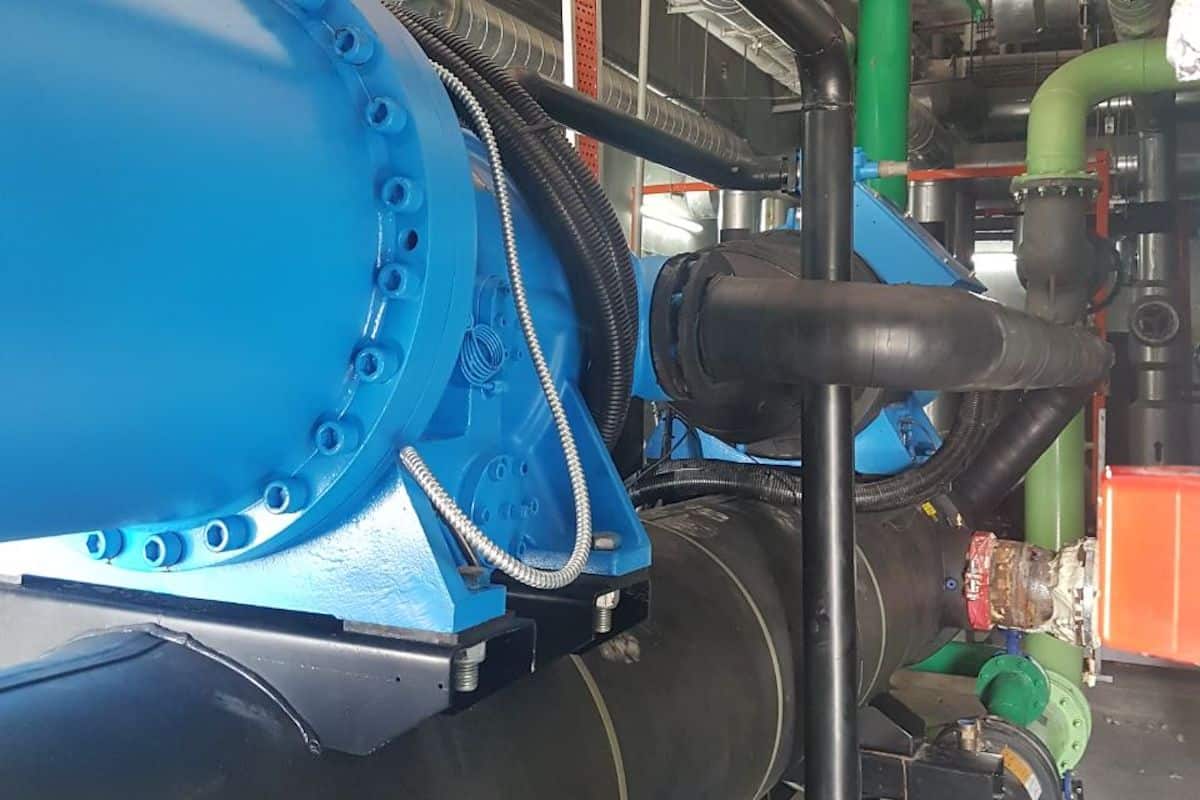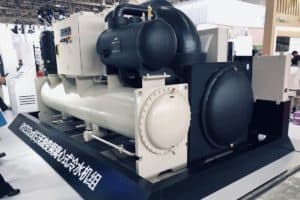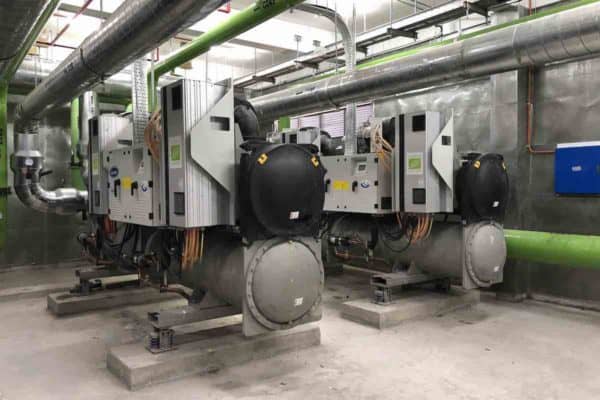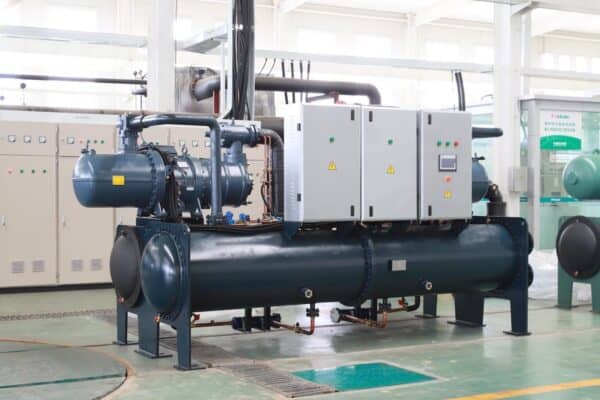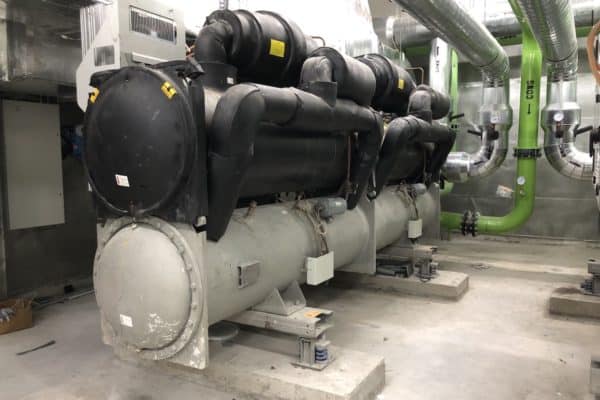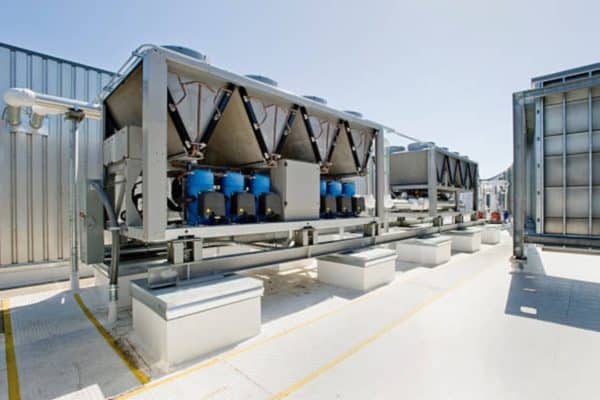What is Economizer in Chiller?
Large chillers often have an economizer to improve energy efficiency. However, engineers often don’t quite understand what is economizer in chiller. So, I did some studies.
Chiller economizer produces cold refrigerant that subcools the main refrigerant line after the condenser to extend the condensation process thereby increasing the refrigeration effect and improving chiller efficiency.
Economizer comes in different forms. However, the basic working principle is the same. Understanding the complex chiller economizer cycle can help you understand other forms of chiller economizer.
How Chiller Economizer Works?
Economizer is a general term used to describe any devices that improve energy efficiency. Hence, it comes in different forms.
For instance, there are air-side economizer and water-side economizer.
An example of an air-side economizer is a split air conditioner utilizing the outdoor air to “free cooling” the room up to 100% when the outdoor temperature condition prohibits. The free cooling may be achieved by means of an exhaust fan or something else. Such a mechanism to improve energy efficiency is known as economizer.
However, economizer is more interesting in water-cooled chillers as it is widely advertised as an optional device that helps water-cooled chillers to achieve high efficiency.
With that said, let’s take a closer look at how chiller economizer works in a water-cooled centrifugal chiller.
Water-Cooled Centrifugal Chiller with Two-Stage Economizer
Large water-cooled centrifugal chillers often use two-stage economizer to achieve high efficiency.
As you might already known, a water-cooled centrifugal chiller consists of 4 major components as follow:
- Centrifugal compressor
- Condenser
- Expansion valve
- Evaporator
Below is a diagram showing the basic operation of a water-cooled centrifugal chiller:
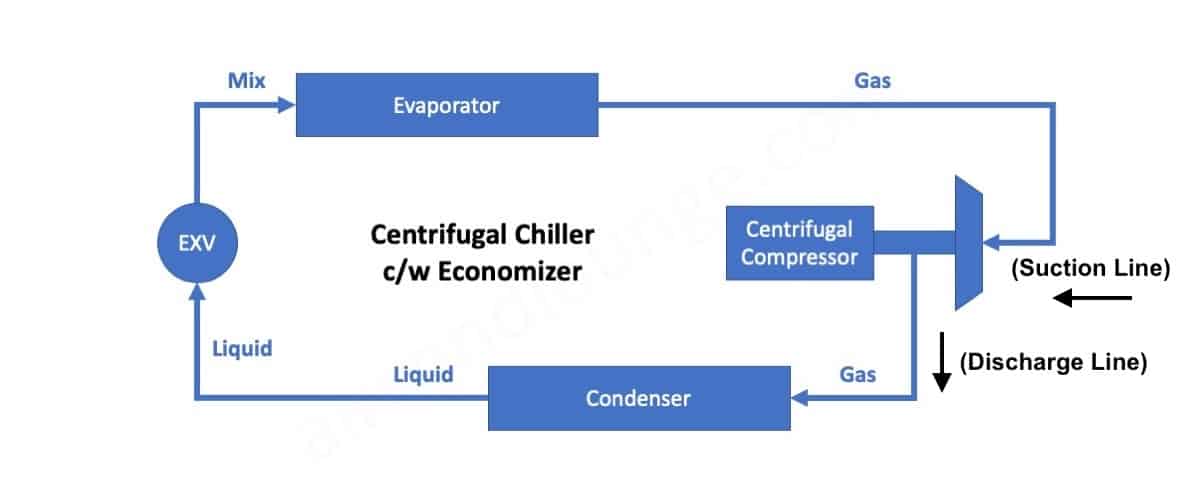
The refrigeration cycle of a water-cooled centrifugal chiller starts by the centrifugal compressor drawing in refrigerant gas at the suction line. Then, the centrifugal compressor compresses the refrigerant gas and send it to the condenser where the heat rejection process occurs with the aid of condenser water.
After that, the refrigerant gas turns into liquid refrigerant and then get expanded into a mixture of liquid and gas refrigerant at the evaporator. Finally, the refrigerant mixture turns into gas refrigerant and the cycle repeats.
Now, let’s put an economizer in the water-cooled centrifugal chiller and see how the cycle looks like.
Below is a diagram showing the operation of a water-cooled centrifugal chiller with economizer:
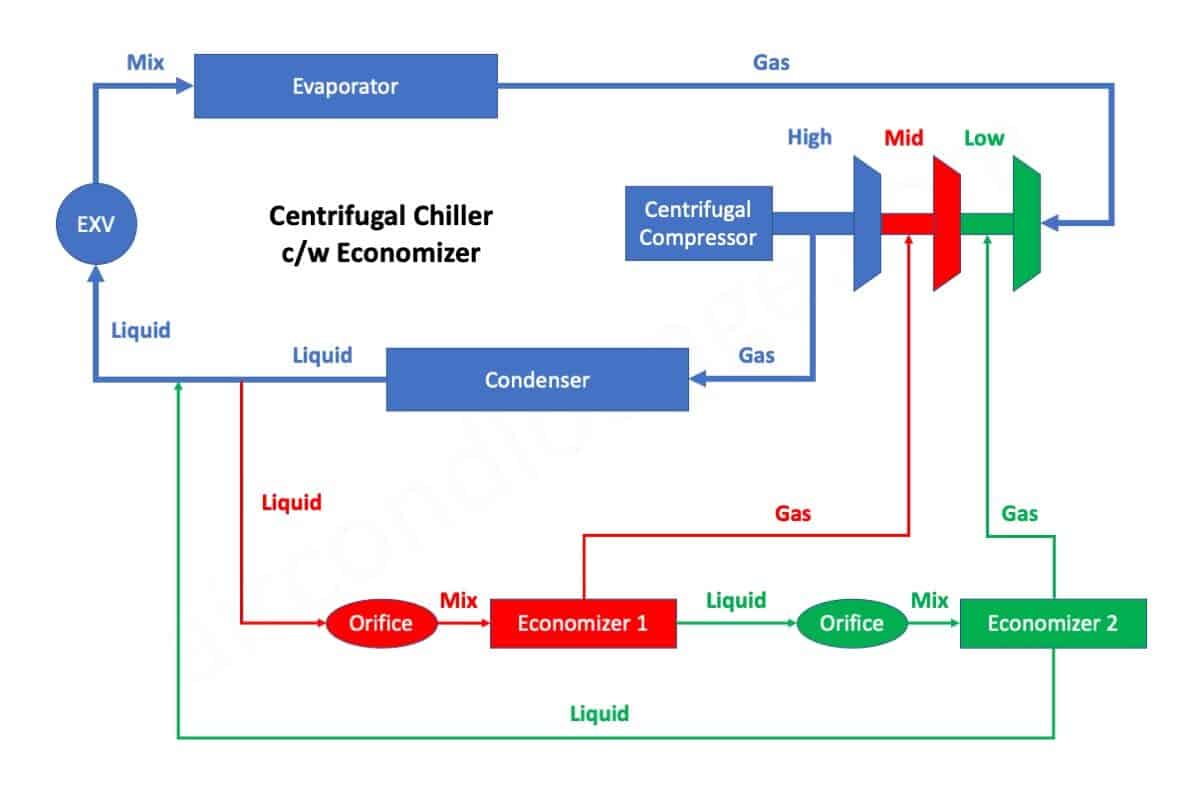
The first thing you’ll notice is two compressor blades are added to the centrifugal compressor. This is because economizer requires the compressor to take in different refrigerant pressures.
Scroll and screw compressors have no problem taking in different refrigerant pressures but centrifugal compressors need refrigerants with different pressures to be added at certain compression stages to ensure proper function of the centrifugal compressor.
The centrifugal compressor shown in the above diagram is known as a three-stage centrifugal compressor or three-stage centrifugal chillers as a whole.
A typical water-cooled centrifugal chiller with economizer diverts in a small amount of liquid refrigerant after the condenser into the economizer.
On a side note, if you want to quickly learn about chilled water system, you can get my Chilled Water System (eBook). If you’re into design, you can enroll in my Chilled Water System Design Course where I teach you various design procedures with tons of examples.
Chilled Water System Design Course
Learn how to design a chilled water system with AHU/FCU selection, chiller sizing, cooling tower sizing, pump sizing, piping design, ductwork design and more.
First Economizer
In the above diagram, there are two economizers. The liquid refrigerant goes into the first economizer where it passes through an orifice beforehand to get expanded.
Needless to say, the liquid refrigerant turns into a mixture of liquid and gas refrigerant inside the economizer which is essentially a tank that holds the refrigerant.
The refrigerant expansion process at the economizer cools the refrigerant mixture. Then, the economizer separate the liquid refrigerant from the gas refrigerant and the liquid refrigerant goes into the second economizer.
If the chiller is using a single-stage economizer, the liquid refrigerant will go back to the main refrigerant line, mixing the “normal” liquid refrigerant and continue the refrigeration cycle.
Now, the gas refrigerant at the first economizer travels to the centrifugal compressor and join the “normal” gas refrigerant at the middle stage or intermediate stage.
The gas refrigerant from the economizer to the compressor is also known as flash gas.
Second Economizer
As mentioned earlier, the liquid refrigerant from the first economizer goes to the second economizer.
Similarly, the cold liquid refrigerant goes from the first economizer through another orifice again which further reduces the pressure and temperature of the refrigerant.
At the second economizer, the liquid refrigerant turns into a mixture of liquid and gas refrigerant once again. Then, the same process repeats; liquid and gas refrigerants are separated.
Once again, the gas refrigerant from the second economizer goes into the centrifugal compressor. However, because the refrigerant goes through the expansion process twice, the pressure of the gas refrigerant from the second economizer is lower than the pressure of the gas refrigerant from the first economizer.
Hence, the gas refrigerant from the second economizer join the normal gas refrigerant at the low stage.
Nonetheless, the pressure of the gas refrigerant from the first economizer and the second economizer is still higher than the pressure of the normal gas refrigerant from the suction line.
Due to the liquid refrigerant leaving the second economizer is colder than the liquid refrigerant leaving the condenser, once the cold liquid refrigerant from the economizer mixes with the liquid refrigerant leaving the condenser, the temperature of the resulted liquid refrigerant reduces thereby gaining extra cooling capacity.
In other words, the refrigeration effect of the refrigeration system increases.
On the other hand, the gas refrigerant from the first economizer and the second economizer has negligible effect on the power consumption of the centrifugal compressor.
Hence, the cooling capacity of the water-cooled centrifugal chiller increases without increasing power consumption. Therefore, its efficiency improved.
The Sub-Cooling Process
The increases in the refrigeration effect of the water-cooled centrifugal chiller with economizer can also be explained with PH diagrams.
Basically, chiller economizer subcools the liquid refrigerant after the condenser, causing the cooling capacity of the refrigerant increases.
Below is a diagram represent the normal refrigeration cycle:

RE stands for refrigeration effect which is basically the cooling capacity of the refrigeration system while HC represents the power consumption of the compressor or simply, the power consumption of the chiller.
Since RE (output) divided by HC (input) equals energy efficiency, the higher the RE and the lower the HC, the better the chiller efficiency.
With economizer, HC basically remain the same but RE increases. As a result, chiller efficiency improved.
Now, let’s add in the economizer and see what happen to the normal refrigeration cycle:
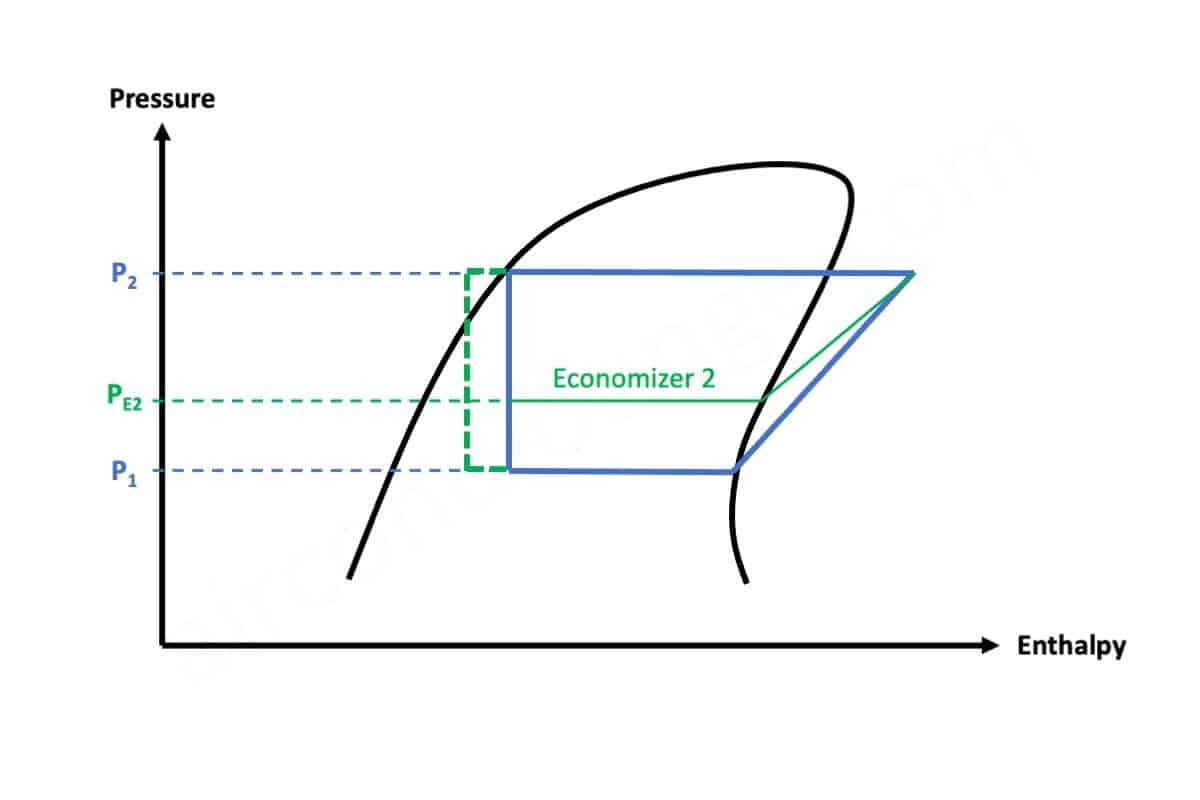
Since the gas refrigerant from the suction line will encounter the gas refrigerant from the second economizer, we’ll start with the second economizer.
In the above diagram, the refrigerant goes through the expansion process at a higher pressure (>P1). Then, the gas refrigerant from the second economizer join the normal gas refrigerant in the compressor process, bringing all gas refrigerants to the same pressure (P2).
Next, the gas refrigerant goes through the condensation process and turns into liquid refrigerant.
Normally, the condensation process stops here and the expansion process begin. However, due to the economizer, the cold liquid refrigerant mixes with the normal liquid refrigeration after the condensation process. As a result, the liquid refrigerant gets sub-cooled as shown in the above diagram.
From there, we can see that the RE without the economizer is shorter than the RE after the economizer; the sub-cooled refrigerant extended the RE or the cooling capacity of the refrigerant.
Now, let’s complete the PH diagram with the first economizer:

With two economizers, the sub-cooling effect is more significant. Thus, the increase in the refrigeration effect is also more significant.
In short, chiller economizer sub-cooled the liquid refrigerant after the condenser to increase the cooling capacity of the refrigerant thereby improving chiller efficiency.
Below is the result of the chiller economizer sub-cooling process:

Whether it is a single-stage economizer or a two-stage economizer, the objective is the same.
From the above diagram, the sub-cool region virtually extended the condensation process which in turn extended the refrigeration effect (from RE1 extended to RE2). Since the power consumption (HC) remain unchanged, chiller efficiency is improved.
So, that’s how economizer improves chiller efficiency.
What is the Purpose of Chiller Economizer?
Chiller economizer increases chiller efficiency without enlarging the physical dimension of the chiller. If we want to subcool the refrigerant like the economizer did but without the economizer, the capacity (physical size) of the compressor and the condenser would need to be increased.
Another way of thinking the purpose of chiller economizer is that the economizer expands the liquid refrigerant once more (single-stage economizer) or twice more (two-stage economizer) on top of the main expansion process to subcool the refrigerant in order to extend its heat absorption capability (cooling capacity).
As for the flash gas (gas refrigerant from the economizer), it is a by-product of the economizer which is “dump” back into the compressor. Because the by-product is small in quantity, the increases in power consumption is negligible.
Therefore, chiller economizer is able to improve chiller efficiency.
In context, water-cooled centrifugal chillers can be 4.5% more efficient with single-stage economizer and 7% more efficient with two-stage economizer. However, economizer also increases the initial cost of the chillers.
Chiller economizer is often an optional component for improved efficiency. Most of the time, economizer makes more sense in large cooling capacity applications.
Summary
Chiller economizer produces cold refrigerant that subcools the main refrigerant line after the condenser to extend the condensation process thereby increasing the refrigeration effect and improve chiller efficiency.
Below is the summary of chiller economizer process:
- A small amount of refrigerant is diverted into the economizer.
- The refrigerant is expanded and gas refrigerant goes back to the compressor.
- The remaining liquid refrigerant flows back to the main refrigerant line.
- The liquid refrigerant from the economizer cools the main refrigerant line.
- The refrigeration effect increases but the power consumption remain unchanged.
- Chiller efficiency improved.
Once again, you can get my Chilled Water System (eBook) to quickly learn more about chilled water system. But, if you want to learn how to design a chilled water system from start to end, I encourage you check out my Chilled Water System Design Course.
Chilled Water System Design Course
Learn how to design a chilled water system with AHU/FCU selection, chiller sizing, cooling tower sizing, pump sizing, piping design, ductwork design and more.
If you have anything to add (or ask) about this topic, leave a comment down below!


